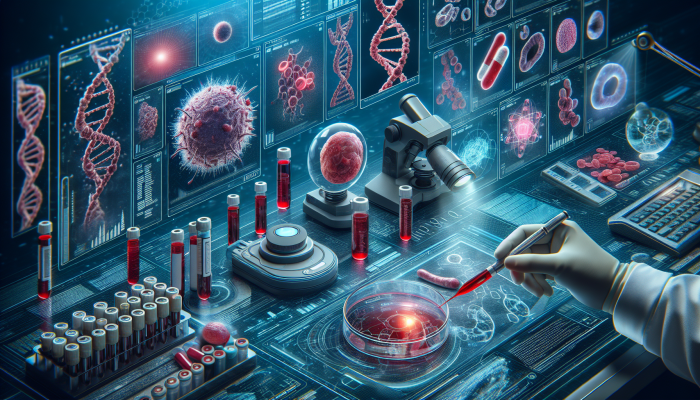Transforming Cancer Detection: Harnessing Advanced Blood Tests and Cutting-Edge Technologies
The landscape of cancer detection is experiencing a remarkable evolution, driven by sophisticated advancements in blood tests for assessing cancer risk. These innovative tests represent a significant progression in identifying potential cancer biomarkers within the human body, which facilitates earlier medical interventions and substantially improves patient outcomes. To effectively navigate the complex and often overwhelming landscape of cancer diagnostics, it is crucial to develop a comprehensive understanding of the fundamental principles that underpin these tests, alongside the latest pioneering innovations emerging within this vital field of healthcare.
Diving Deep into the Science of Blood Tests for Cancer Risk: Comprehensive Analysis

At the core of blood tests for cancer risk lies the essential detection of specific biological indicators known as biomarkers. These biomarkers serve as crucial signals indicating the potential presence of cancer or an increased risk of developing it in the future. They encompass a wide array of substances, including proteins, genes, and a variety of other materials produced either by malignant cells or by the body’s immune response to the presence of cancer. The scientific principles guiding these groundbreaking tests rely on sophisticated methodologies that accurately identify these markers, employing an extensive range of state-of-the-art technologies.
A key methodology utilized in these evaluations is the liquid biopsy. This pioneering technique involves analyzing a blood sample to detect elements such as circulating tumor DNA (ctDNA) and circulating tumor cells (CTCs). The non-invasive nature of this approach allows for a thorough assessment of a patient’s cancer risk without the need for more invasive procedures, such as traditional biopsies. Furthermore, advancements in technology, particularly in next-generation sequencing (NGS), have significantly enhanced the sensitivity and specificity of these tests, allowing for the detection of even the faintest traces of ctDNA.
The accuracy of blood tests for cancer risk is closely linked to our understanding of cancer biology. Various cancer types release distinct biomarkers into the bloodstream, prompting ongoing research aimed at uncovering new markers that could function as early warning signals. For example, levels of prostate-specific antigen (PSA) are regularly monitored to assess prostate cancer risk, while the CA-125 marker is frequently associated with the detection of ovarian cancer.
Additionally, the integration of artificial intelligence (AI) into the analysis of test results is significantly reshaping this field. AI algorithms can process vast datasets, revealing patterns that might be overlooked through human analysis, thereby greatly improving the predictive power of these tests.
Unveiling Cutting-Edge Innovations in Blood Tests for Cancer Risk: Major Breakthroughs
The domain of blood tests for cancer risk is currently witnessing extraordinary innovations that have the potential to revolutionize cancer screening and prevention methodologies. A particularly impactful advancement is the emergence of multi-cancer early detection (MCED) tests. These groundbreaking tests are designed to detect multiple cancer types from a single blood sample, thereby significantly minimizing the necessity for invasive procedures and enhancing overall patient comfort and experience.
Recent studies have indicated that MCED tests can effectively identify cancers at their earliest stages, often before clinical symptoms become apparent. This early detection is critical as it is directly associated with improved treatment outcomes and increased survival rates. For instance, research published in a leading oncology journal highlighted the remarkable ability of an MCED test to detect malignancies that are traditionally difficult to diagnose early, such as pancreatic cancer and ovarian cancer.
Another significant advancement in this field involves the exploration of methylation patterns present in circulating DNA as a diagnostic tool. Alterations in methylation often indicate cancerous processes, prompting researchers to investigate how these patterns can be utilized for more precise cancer risk assessment. This innovative approach could provide a highly sensitive method for detecting cancers that currently lack effective screening protocols, thus enhancing patient care.
Moreover, collaborations between technology enterprises and healthcare providers are driving the development of novel diagnostic tools. These partnerships aim to leverage big data and machine learning to improve the analysis of blood samples, resulting in more accurate risk assessments and customized management strategies for patients.
Examining the Groundbreaking Role of Liquid Biopsies in Cancer Detection and Therapeutic Approaches
Liquid biopsies represent a significant advancement in the realm of blood tests for cancer risk. Unlike traditional biopsies that require invasive tissue samples, liquid biopsies offer a minimally invasive alternative that can be performed multiple times, facilitating ongoing monitoring of cancer progression or treatment responses. This capability is particularly advantageous for patients who may not be suitable candidates for surgical biopsies due to varying health factors.
Liquid biopsies function by isolating and analyzing ctDNA or CTCs extracted from a blood sample. The capacity to monitor these cellular components provides valuable insights into tumor dynamics and potential genetic mutations that may occur throughout the course of the disease. Identifying specific mutations can assist oncologists in selecting targeted therapies, thereby personalizing treatment plans for enhanced therapeutic efficacy and success rates.
The integration of liquid biopsies into clinical practice is already delivering promising outcomes. Recent clinical trials have demonstrated that these tests can detect recurrences in patients who have previously undergone cancer treatments, often several months prior to the detection methods employed by traditional imaging techniques. This timely identification can enable prompt interventions, ultimately improving survival outcomes and overall patient health.
Additionally, liquid biopsies allow for real-time monitoring of treatment effectiveness. By evaluating ctDNA levels during therapy, healthcare professionals can gauge the success of the treatment regimen and make necessary adjustments to optimize patient care. This proactive monitoring approach signifies a major shift toward a more dynamic management of cancer care, ensuring that patients receive the most effective treatment tailored to their unique needs.
In essence, blood tests for cancer risk, particularly through the implementation of liquid biopsies, are revolutionizing the oncology field. Their potential for early detection, continual disease monitoring, and personalized therapeutic strategies positions them as indispensable tools in the ongoing fight against cancer. As research and technological advancements continue to progress, the future for these tests to enhance patient outcomes and transform cancer care remains exceptionally promising and encouraging.
Engage with Us: Join Our Facebook Community for the Latest News and Updates!

This Article Was First Published On https://bloodtest.co.uk
The Article: Blood Tests for Cancer Risk: Pioneering Early Detection Methods appeared first on: https://ezbloodtest.com
The Article Cancer Risk Blood Tests: Innovative Methods for Early Detection Was Found On https://limitsofstrategy.com

